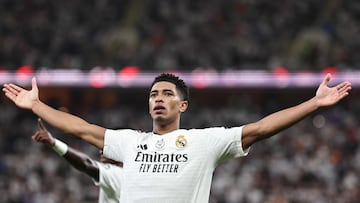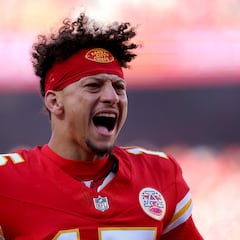Goodbye to celebrating like your favourite player: this is how much it will cost
Dani Olmo, Kylian Mbappé, Jude Bellingham and Cole Palmer have all copyrighted their goal celebrations, meaning nobody can copy them.

You score a goal, celebrate by pointing at an imaginary watch, pretend to be cold, or cross your arms and open them out wide. Days later, you’re sued for damages.
It sounds like a businessman’s attempt at a Stephen King horror short, but it’s a real possibility. According to the European Union Intellectual Property Office (EUIPO), gestures used by players like Dani Olmo, Cole Palmer, Kylian Mbappé, and Jude Bellingham are now officially registered: this means no one can replicate them without permission. These footballers have secured exclusive rights to their iconic celebrations across the continent for at least ten years.
From Hugo Sánchez’s somersaults to Ronaldinho’s maracas, Cristiano Ronaldo’s signature spin, and Messi’s fingers pointing to the sky, fans have always imitated their idols. But modern football has taken this a step further—players now register their celebrations as part of their personal brand. This move enables them to monetise their gestures through merchandise and advertising campaigns. Celebrating is no longer just a moment of joy; it’s a way to showcase a trademark.
They told Dani Olmo to do his celebration to the fans 😍😍⌚️pic.twitter.com/CQfkiqlICm
— ᴘɢ² (@angrygavi) January 13, 2025
Mbappé leads the way
The trailblazer in this trend was Kylian Mbappé, who registered his iconic goal celebration—arms crossed over his chest—in February of last year. He filed for protection across all 27 European Union countries, his primary market. Shortly after, Jude Bellingham followed suit, registering his celebration: arms outstretched, legs apart, and a confident gaze straight ahead.
The first Spanish player to adopt this practice was Dani Olmo, who filed his application in December 2024. To mark the New Year, the FC Barcelona player shared his signature “watch celebration” on social media, which had been registered with the EUIPO on December 11. Along with securing his name and gesture, Olmo registered his brand across six product categories, including colognes, watches, stationery, backpacks, clothing, toys, and video games.
Most recently, Cole Palmer filed for his “cold celebration” at the end of 2024, although his application is still under review. This move sparked controversy among Valencia fans, as Diego López of Valencia and Spain’s Under-21 team had already been celebrating goals in a similar manner. López even tweeted a photo of himself performing the gesture, challenging Palmer’s claim.
The Bernabeu crowd copied Jude Bellingham's celebration last night 🥶 pic.twitter.com/h7iO6tm3XJ
— FourFourTwo (@FourFourTwo) September 21, 2023
The cost and benefits of trademarked celebrations
Footballers don’t receive direct monetary payouts for registering celebrations, but they gain exclusive rights to commercialise their gestures. Trademarking prevents others from profiting off identical or confusingly similar representations. A simple celebration can become a lucrative trademark for products ranging from school supplies to cosmetics, toys, and apparel.
The process involves filing an application, undergoing a three-month opposition period during which others can contest the claim, and registering the trademark under specific categories outlined in the Nice Classification system. Filing fees start at €850, increasing based on the number of categories selected. For footballers, this cost is negligible compared to the potential profits.
Young Kylian Mbappé doing the iconic Cristiano Ronaldo SIUUU celebration. pic.twitter.com/ORFTPqiy8p
— KM (@Kylian) January 8, 2025
What happens if another player copies a celebration?
Players who imitate celebrations like those of Bellingham, Mbappé, Olmo, or Palmer risk legal claims—if their actions are for commercial purposes or financial gain. However, if there’s no profit or malice involved, such cases usually end as anecdotes. As there has been no case with the aforementioned celebrations, there is no current sense of potential monetary repercussions.
Disputes arise when others have used a celebration first. If proof of prior use is presented during the opposition period, the trademark application can be overturned. For instance, Diego López or Morgan Rogers could challenge Palmer’s claim, as Rogers has publicly acknowledged using the gesture before Palmer. Similarly, Dani Olmo’s celebration faced competition from other players like Masca and Muniain, though his approved trademark makes challenges more difficult.
A broader trend in sports
This phenomenon isn’t new. In 1999, Nike trademarked Michael Jordan’s iconic slam dunk silhouette. Usain Bolt also registered his victory pose—one arm bent and pointing, the other extended skyward. Monetising iconic movements has been a reality for years.
Didier Drogba doing the “cold” celebration v Rosenborg in 2007 🥶 pic.twitter.com/JEJvMjopwW
— Archives (@CFCRetro) October 3, 2024
Related stories
Bellingham, Mbappé, Palmer, and Olmo are pioneers in football’s foray into trademarked celebrations, but they won’t be the last.
Follow the Diario AS channel on WhatsApp, where you will find all the sport in one place: the current news of the day, the agenda with the latest news on the most important sporting events, the most outstanding images, the opinion of the best AS writers, reports, videos, and some humour from time to time.


Complete your personal details to comment